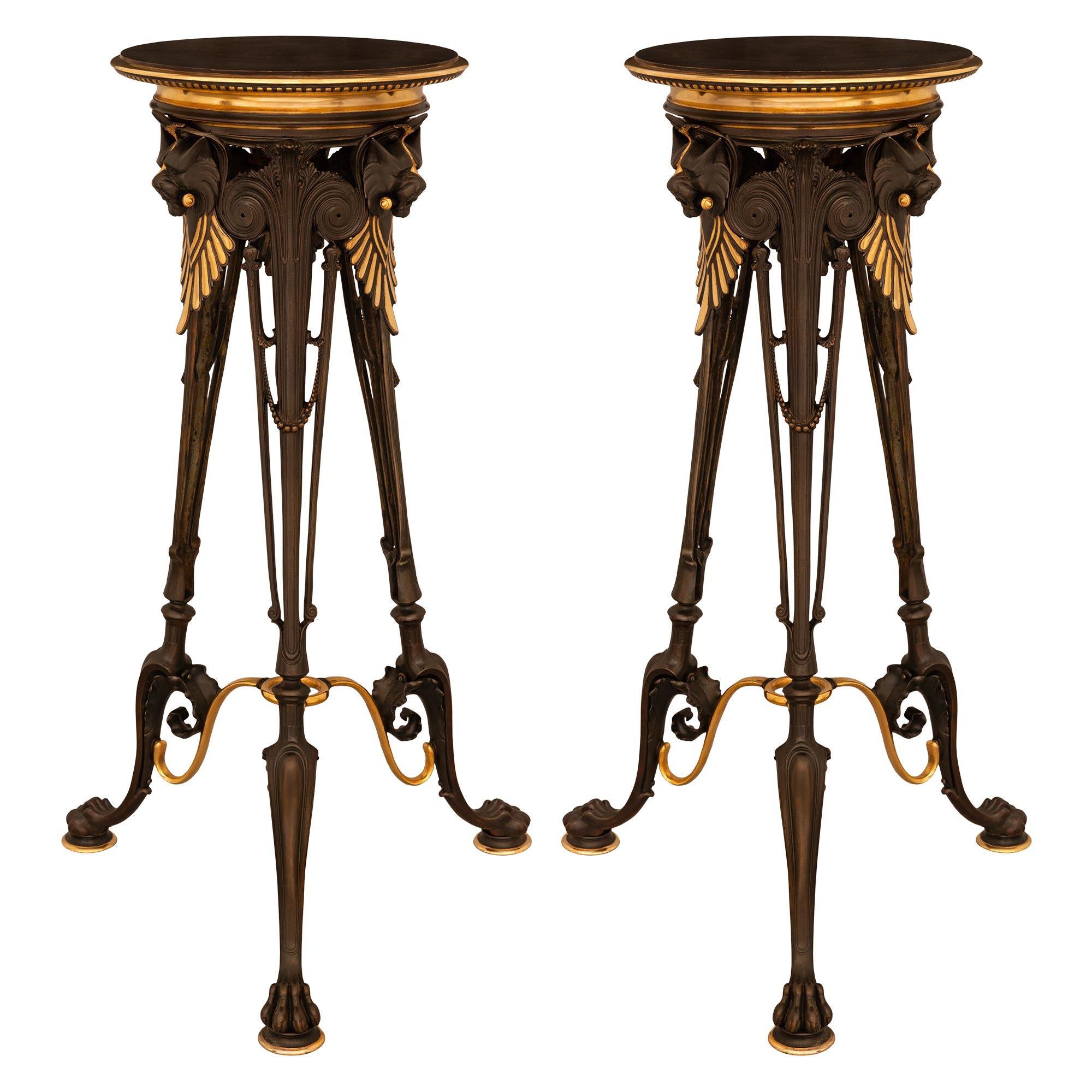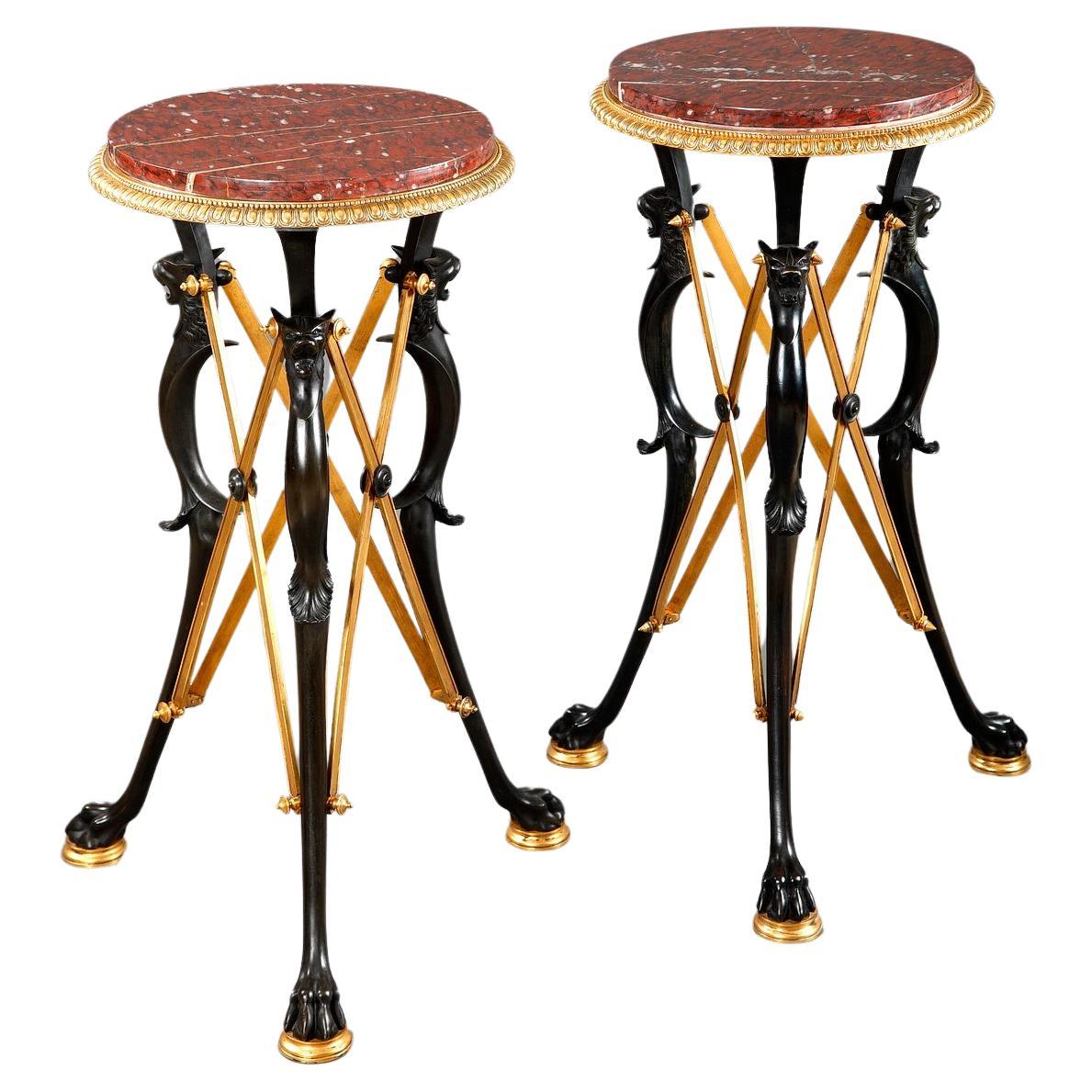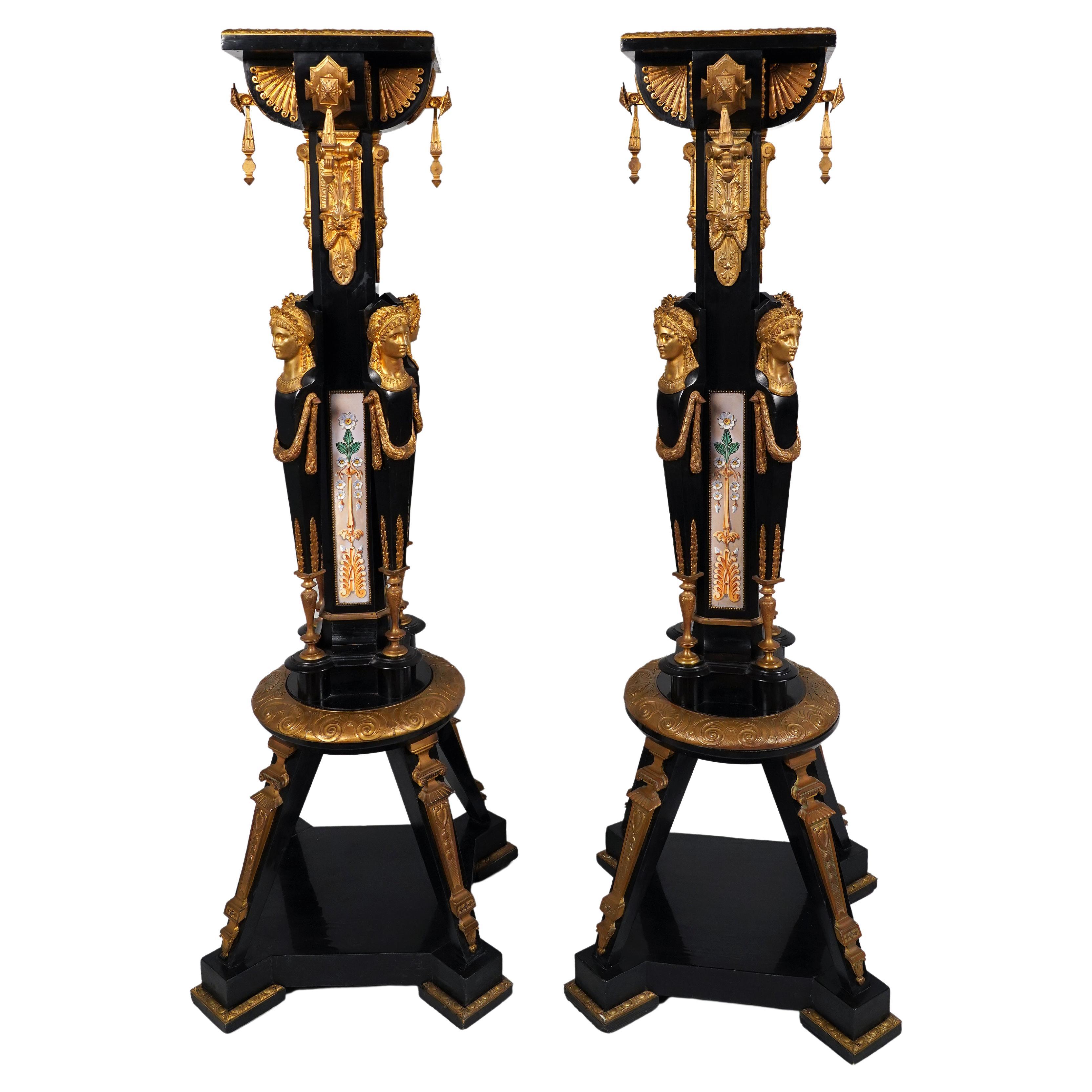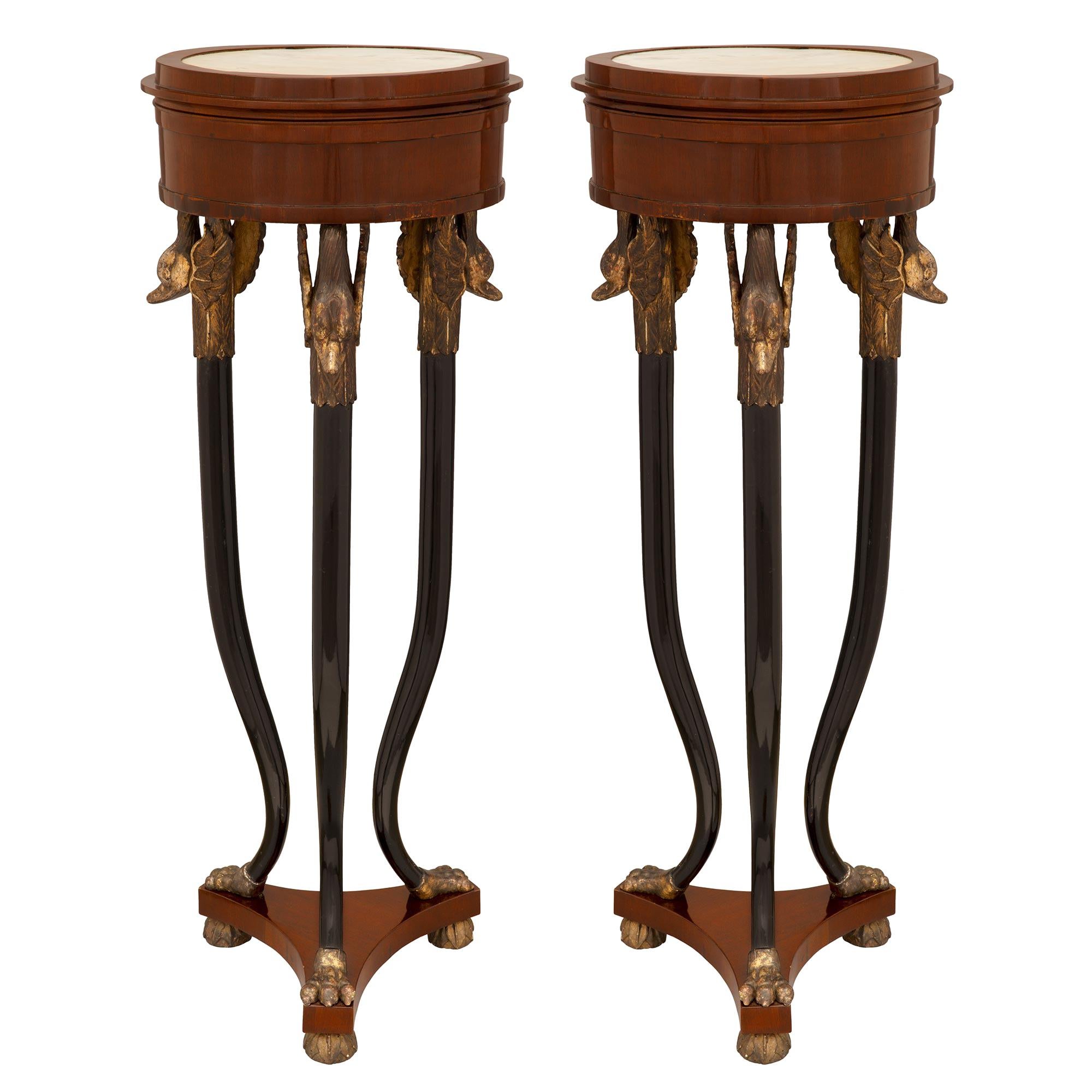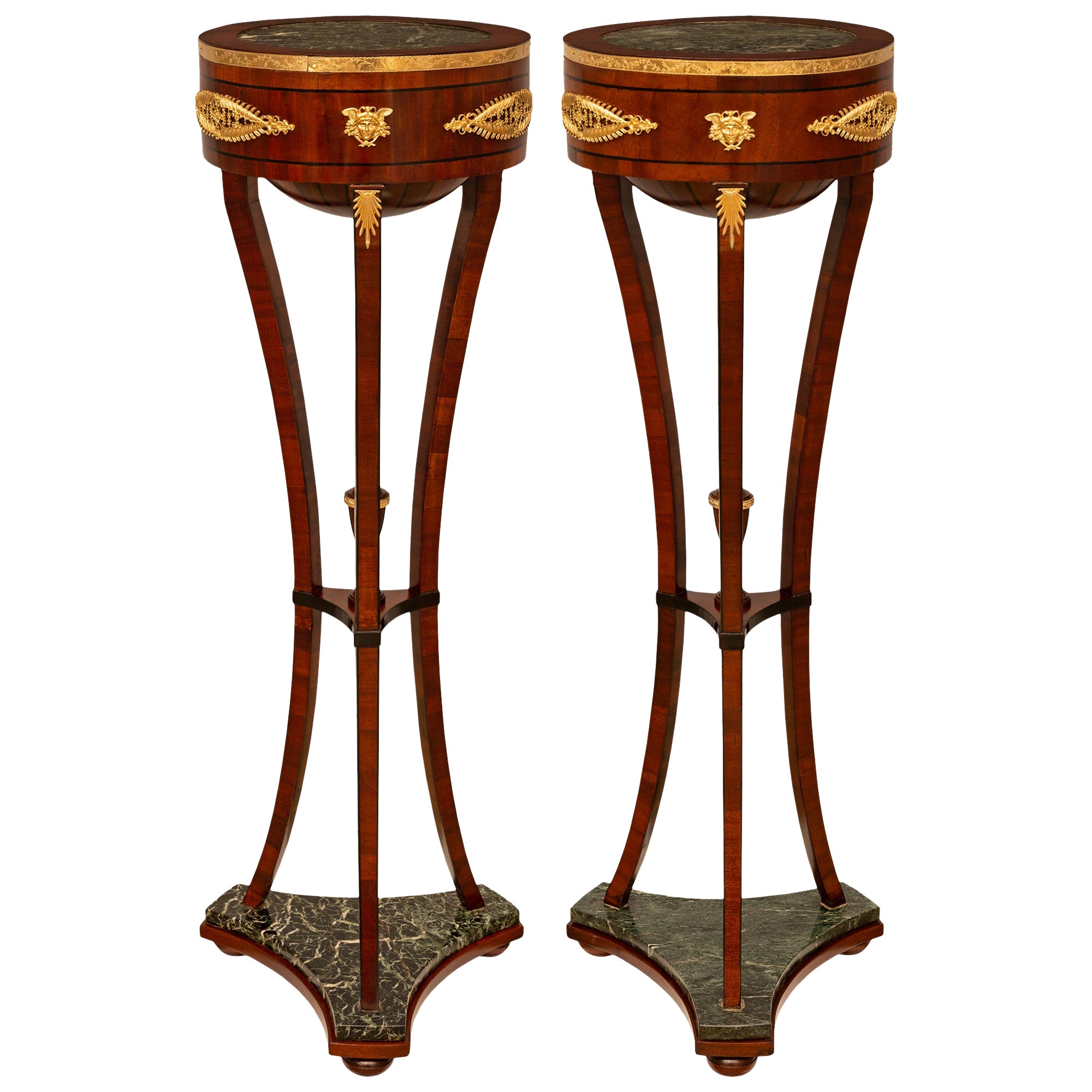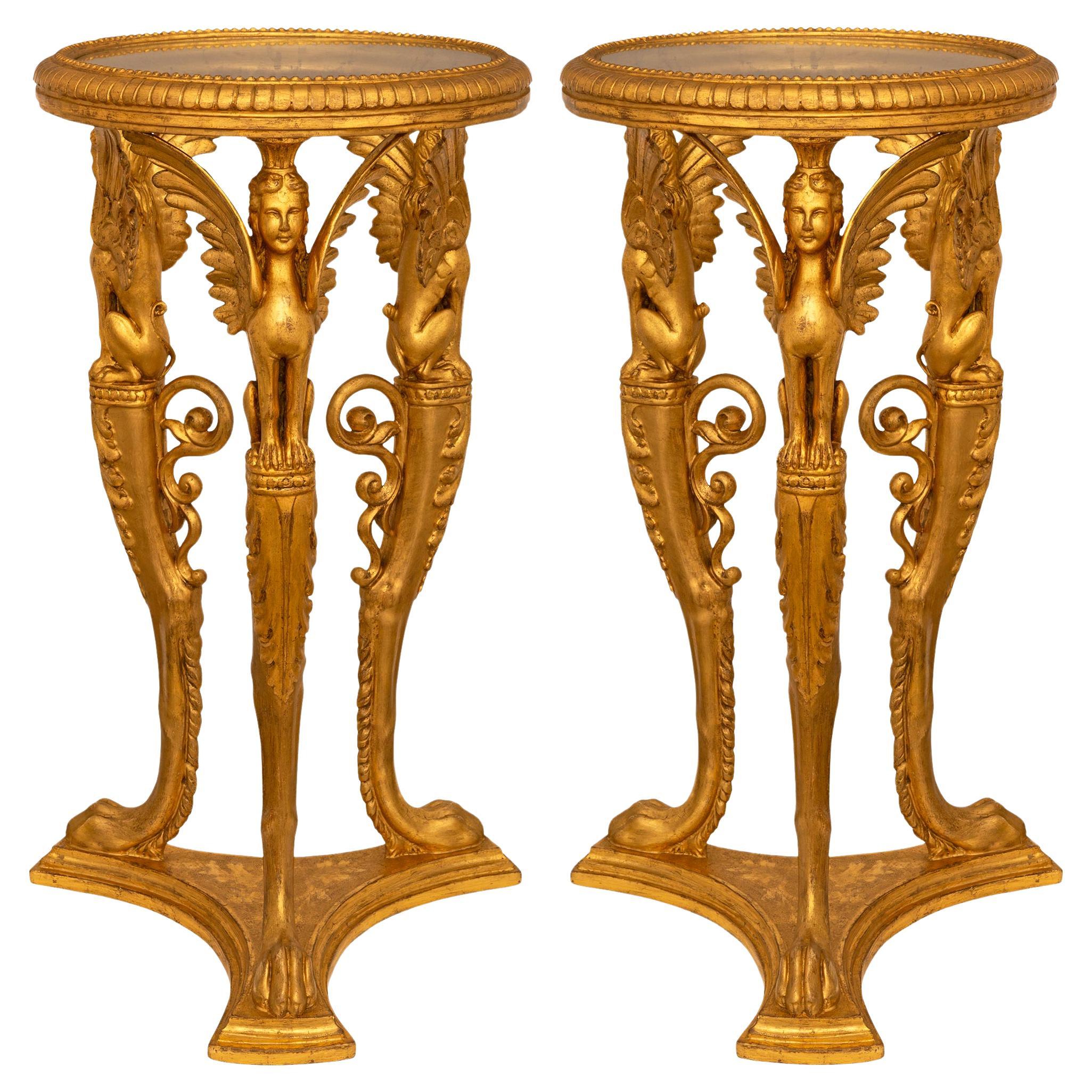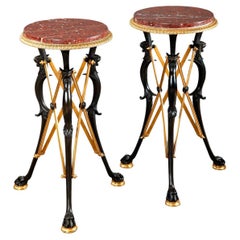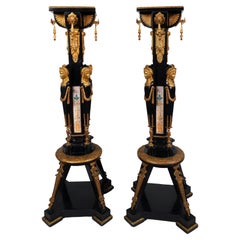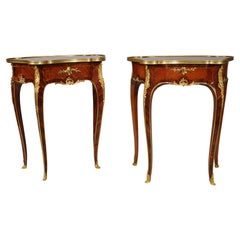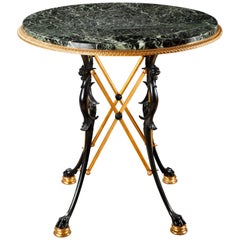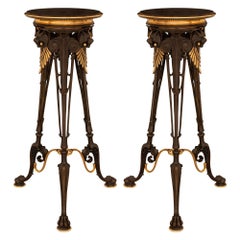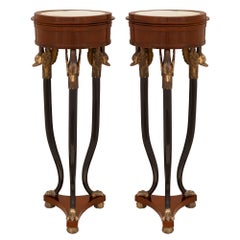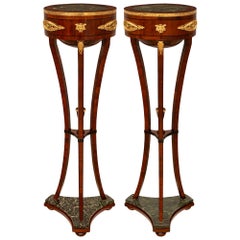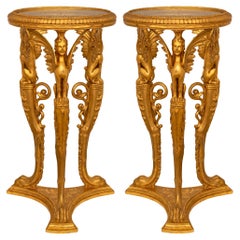Items Similar to Pair of Neo-Greek Pedestals, attributed to G.Servant, France, Circa 1880
Want more images or videos?
Request additional images or videos from the seller
1 of 8
Pair of Neo-Greek Pedestals, attributed to G.Servant, France, Circa 1880
$57,238.19per set
£42,813.71per set
€48,000per set
CA$79,079.25per set
A$86,227.44per set
CHF 45,760.04per set
MX$1,042,461.88per set
NOK 579,126.53per set
SEK 530,850.02per set
DKK 365,680.76per set
About the Item
Pair of patinated and gilded bronze turntable pedestals with for each of them, three paw feet, headed by stylized lion muzzles, ornated with beaded chains and joined by a fine foliate stretcher. The belt is adorned by a banded frieze cast in low-relief representing an ancient scene : “The Battle of the Lapithes and the Centaurs”.
These pedestals can be associated with the "Vases de Bacchus", presented by G. Servant at the 1867 Exposition Universelle, on which the similar ornamentation is applied.
(Reproduced in « Merveilles de l'Exposition Universelle de 1867 », Jules Mesnard, p°167)
Biography :
Georges Emile Henri Servant (1828-c.1890), who took over his father in 1855 at their foundry, rue Vieille-du-Temple, in Paris, specialized in the production of neo-Egyptian style clocks, very popular in France since 1860's, and also the making of Greek style decorative objects. He drew considerable attention to the high quality of his bronzes at the 1855 Paris Universal Exhibition and then at the 1862 London Exhibition. At this time Servant exported up to 40% of his production, principally to the United States, where for instance, his clocks were sold with great success by Louis Tiffany Inc. or Hamann & Roche of New York. But his success came really at the 1867 Paris Universal Exhibition, where he was awarded a gold medal for his neo-Greek and Egyptian works (Les Merveilles de l'Exposition Universelle de 1867, t. II, p° 165 & 167). He was even awarded in 1874 the « Ordre national de la Légion d'Honneur », France's hightest official mark of recognition. Servant participated once again successfully at the 1878 Paris Universal Exhibition, where he not only exhibited vases and small bronze pieces of furniture, but was also a member of the jury for the class of bronze pieces of art. He finally retired shortly before the 1889 Paris Universal Exhibition.
- Attributed to:Georges Emile Henri Servant (Metalworker)
- Dimensions:Height: 38.78 in (98.5 cm)Diameter: 15.75 in (40 cm)
- Sold As:Set of 2
- Style:Greek Revival (In the Style Of)
- Materials and Techniques:
- Place of Origin:
- Period:
- Date of Manufacture:Circa 1880
- Condition:Wear consistent with age and use.
- Seller Location:PARIS, FR
- Reference Number:Seller: ref. 1747/11stDibs: LU3860337152502
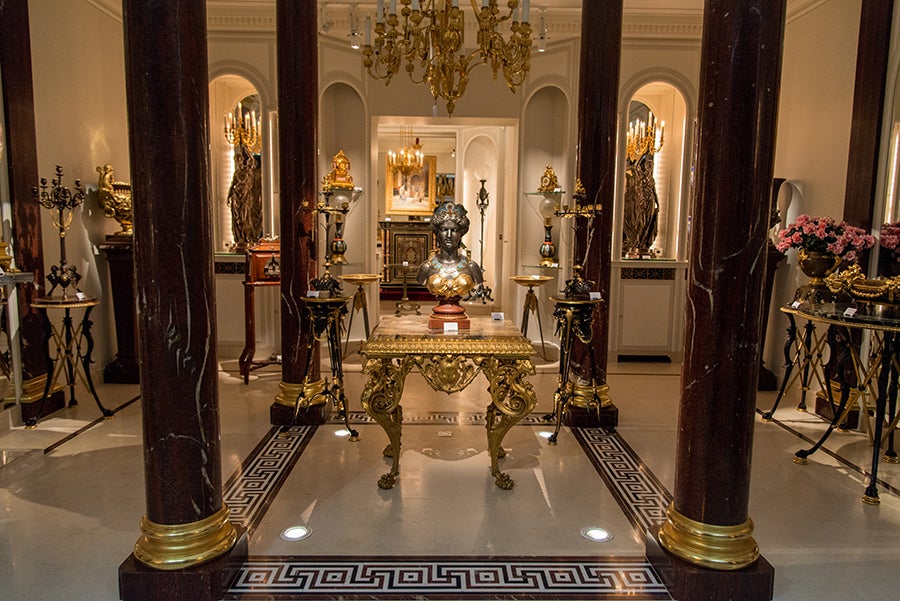
About the Seller
4.9
Gold Seller
Premium sellers maintaining a 4.3+ rating and 24-hour response times
Established in 1997
1stDibs seller since 2018
91 sales on 1stDibs
Typical response time: 2 hours
Associations
International Confederation of Art and Antique Dealers' Associations
- ShippingRetrieving quote...Shipping from: PARIS, France
- Return Policy
More From This Seller
View AllPair of Neo-Greek Gueridons Attr. to L.C Sevin & F. Barbedienne, France, c. 1880
By Ferdinand Barbedienne, Louis-Constant Sevin
Located in PARIS, FR
Pair of patinated and gilded bronze high guéridon attributed to L.C Sevin and F. Barbedienne, with for each of them, three paw feet joined by X shaped stretche...
Category
Antique 1880s French Greek Revival Gueridon
Materials
Griotte Marble, Bronze
Pair of Neo-Greek Pedestals. C.G. Diehl & J.Brandely, France, circa 1867
By Jean Brandely, Charles-Guillaume Diehl, Lebeuf Milliet & Cie Creil Montereau
Located in PARIS, FR
Exceptional pair of neo-Greek style pedestals, made in blackened pearwood, gilded galvanic bronze and glazed earthenware. The sheath-shaped shaft is decorated with rectangular plates...
Category
Antique 1860s French Greek Revival Pedestals
Materials
Bronze
Pair of Tables attr. to J.-E. Zwiener, France, circa 1885
By Joseph-Emmanuel Zwiener
Located in PARIS, FR
Charming Louis XV style tables forming a pair, in a scalloped shape, opening with a drawer on the belt and made in wood veneer. Their tray surrounded by a bronze mold is decorated wi...
Category
Antique 1880s French Louis XV Tables
Materials
Bronze
Neo-Greek Gueridon Attributed to F. Barbedienne, France, Circa 1880
By Ferdinand Barbedienne, Louis-Constant Sevin
Located in PARIS, FR
A similar model was exposed at the 1889 Paris Universal Exhibition ( see picture attached)
Patinated and gilded bronze gueridon with four paw feet joined by X-shaped stems, attributed to Sévin and Barbedienne. Round green marble top mounted with a bronze rim adorned with oves and pearls motif.
Born in 1821 and dead in Paris in 1888, Louis-Constant Sévin was apprenticed to the parisian sculptor Marneuf. In 1839, he joined the sculptor-modelors Phénix and Joyau, as designer, and designed silver-smith’s objects for famous firms like Denière, Froment-Meurice, Morel and Duponchel. During the Revolution in 1848, C. Sévin joined Morel in London, as workshop manager and designed pieces that Morel exhibited in 1851. Back in France in 1851, C. Sévin went to Limoges and designed models for the porcelain factories of Jouhanneaud and Dubois of which many pieces were exhibited at the Universal Exhibition in 1855. From this date on, he worked for Ferdinand Barbedienne as sculptor-ornemanist until the end of his life. Sévin’s works are considerable, he designed furniture bronzes for the « hôtel de La Païva ». At the London Exhibition in 1862, he was awarded a medal « pour l’excellence artistique des meubles qu’il a dessinés et qui sont exposés par Barbedienne » : for the artistic excellence of the furniture he designed and which is exhibited by F. Barbedienne. He won a second class medal at the Union centrale des Arts décoratifs Exhibition in 1863 and was awarded a gold medal as « cooperator ». F. Barbedienne said that posterity would remember Sévin’s compositions. The most extraordinary object designed by C. Sévin for F. Barbedienne, was a Renaissance style gilded bronze monumental clock...
Category
Antique 1880s French Greek Revival Center Tables
Materials
Marble, Bronze
Pair of Marble and Bronze Urns on Marble Pedestals, France, Early 20th Century
Located in PARIS, FR
Measures: Height : 29 cm (11,4 in.) ; width : 61,5 cm (24,2 in.) ; depth : 55,5 cm (21,8 in.)
Total height : 139 cm (54,7 in.)
Important pair of rare Greek...
Category
Early 20th Century French Neoclassical Planters, Cachepots and Jardinières
Materials
Marble, Bronze
$73,932 Sale Price / set
29% Off
Pair of Neo-Gothic Stands, France, Circa 1880
Located in PARIS, FR
A very fine pair of Gothic Revival natural wood stands. Each composed of a hexagonal molded red Griotte marble top, resting on a hexagonal tapering shaft. Adorned all-over with carve...
Category
Antique 1880s French Gothic Revival Pedestals
Materials
Griotte Marble
$5,723 / set
You May Also Like
Pair Of French 19th Century Neo-Greek St. Ormolu And Patinated Bronze Pedestals
Located in West Palm Beach, FL
A most impressive pair of French 19th century Neo-Greek st. Ormolu and patinated Bronze pedestals, attributed to G. Servant, France, Circa 1880. Each handsome pedestal is raised by t...
Category
Antique 19th Century French Pedestals and Columns
Materials
Bronze, Ormolu
Pair of Italian 19th Century Neoclassical St. Pedestals
Located in West Palm Beach, FL
An extremely elegant pair of Italian 19th century neoclassical St. mahogany, ebony, Mecca and white Carrara marble pedestals. Each pedestal is raised by a triangular base with concav...
Category
Antique 19th Century Italian Neoclassical Pedestals
Materials
Carrara Marble
Pair Of Baltic 19th c. Neo-Classical St. Ormolu, Mahogany, And Marble Pedestals
Located in West Palm Beach, FL
A stunning pair of Baltic 19th century Neo-Classical st. Ormolu, Mahogany, and Vert de Patricia marble pedestals. Each beautiful pedestal is supported by a triangular Vert de Patrici...
Category
Antique 19th Century Baltic Neoclassical Tables
Materials
Marble, Ormolu
A pair of Italian early 19th century Neo-Classical st Giltwood & Glass pedestal
Located in West Palm Beach, FL
A beautiful and most decorative pair of Italian early 19th century Neo-Classical st. Giltwood and Glass pedestals. Each very attractive pedestal is raised by three pierced cabriole l...
Category
Antique Early 19th Century Italian Neoclassical Pedestals
Materials
Glass, Giltwood
Pair Italian Early 19th Century Neoclassical Pantinted and Parcel-Gilt Pedestals
Located in New York, NY
Pair Italian Early 19th century Neoclassical pantinted and Parcel-gilt pedestals
Each fitted with a circular marble top.
56 1/2 x 16 in. diam.
Provenance: Lou Marotta Antique...
Category
Antique Early 19th Century European Neoclassical Pedestals
Materials
Wood
Pair Of French 19th Century NeoClassical St. Mahogany, Ormolu & Marble Pedestals
Located in West Palm Beach, FL
An elegant and most decorative pair of French 19th century Neo-Classical st. Mahogany, Ormolu and Vert Campan marble pedestal tables. These two tiered stunning single drawer tables a...
Category
Antique 19th Century French Neoclassical Pedestals and Columns
Materials
Marble, Ormolu
More Ways To Browse
Lion Chain
Small Pedestal Table Wood
Burlwood Pedestal
Chinese Incense Stand
Chinoiserie Plant Pedestal
Urn Pedestal Dining Tables
Adjustable Pedestal Table
Black Display Pedestal
Square Stone Dining Table
Tall Wood Plant Stands
Thonet Flower
Antique Fern Stand Table
Antiqued Mirror Pedestal
Black Granite Pedestal
Drum With Stand
Maitland Smith Drum Table
Marble Pedestals 18
Modernist Plant Stand
